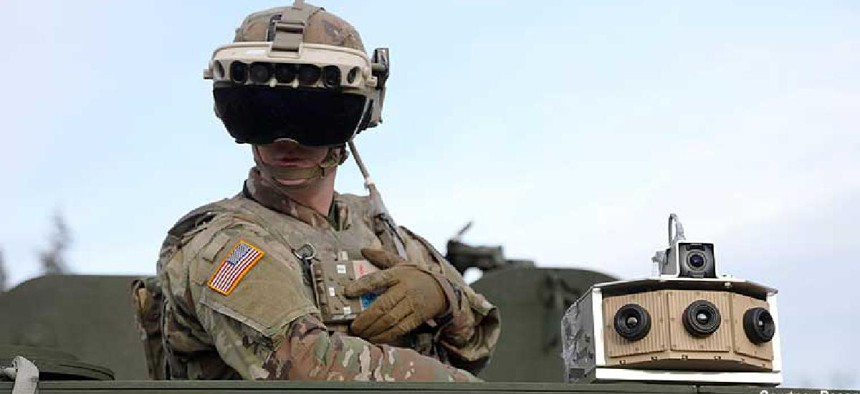Army shifts AR into high gear with $22B contract for customized HoloLens goggles

The Army will be fielding more than 120,000 custom, ruggedized versions of Microsoft’s HoloLens headsets that use augmented reality to project situational awareness information directly onto a soldier’s visor.
The Army plans to field more than 120,000 custom, ruggedized versions of Microsoft’s HoloLens headsets designed to project situational awareness information directly onto a soldier’s visor.
The Integrated Visual Augmentation System program looks at the soldier as a weapons system, the Army said. IVAS integrates key capabilities – such as high-resolution night, thermal and soldier-borne sensors as well as radio communications -- into a single, lightweight wearable device to improve information sharing and decision making for warfighters.
The system has also been fitted with facial recognition and language translation tools as well as rapid target acquisition and identification, performance assessment and biometric applications. It leverages augmented reality capabilities that enable the overlay of map displays, data or simulated images onto a soldier's view of the real environment.
The display is also connected to a soldier's weapon sensor, IVAS project manager Col. Chris Schneider said at a July 2019 media event. That means a rifle's muzzle and barrel pop into view of the headset as the weapon is raised and aimed, similar to the user view in the Halo first-person shooter game. Schneider said that feature can improve shooting accuracy.
Machine learning allows forces to better train in a mixed reality training environment before engaging any adversaries, the PEO Soldier office said in its announcement of the $22 billion, 10-year contract.
While the Army has been testing and developing IVAS since 2018, until recently, the program was focused on improving the goggles for dismounted soldiers. Now the Army is looking to give the headset’s situational awareness capabilities to mounted warfighters as well. That means soldiers being transported to the battlefield would not only see a screen depicting what the driver or gunner sees, but also get information on the surrounding territory from the vehicle’s sensors. Each IVAS-wearing soldier would be able to “see through” the transport vehicle, with data from the vehicle’s external sensors feeding into their individual headsets, Army officials said in February.
“Up until this point IVAS has really been focused on the dismounted soldiers and getting that fighting goggle right,” said Maj. Kevin Smith with the C5ISR Night Vision and Electronic Sensors Directorate. “So in parallel, we … have been working to build-in applications to leverage both new and existing sensors on the vehicles to give the soldier not just enhanced visual situational awareness, but also C2 [command and control] situational awareness while they're inside of a platform or vehicle.”
“This changes how we operate honestly,” said Sgt. Philip Bartel with the 1-2 Stryker Brigade Combat Team. “Now guys aren't hanging out of vehicles in dangerous situations trying to get views on what's going on. Leadership will be able to maneuver their elements and get view-on-target without having to leave the safety of their armored vehicles. Maneuvering elements with that kind of information will minimize casualties and will overall drastically change how we operate and increase our effectiveness on the battlefield.”
IVAS is augmented by Microsoft’s Azure cloud infrastructure. Alex Kipman, a technical fellow at Microsoft, wrote in a blog post.
“One of the goals of IVAS was that it's going to be a fighting goggle as well as a training goggle and we are 100% attempting to bring both to reality,” said SFC Joshua Braly of the Soldier Lethality Cross Functional Team. “This is one of those key moments in our military's history where we're able to look back and acknowledge that we're not where we want to be and we're willing to make bold strides to get there. IVAS is without question an effort to do that, and we're working diligently every day to make this a reality.”
The new production award comes nearly three years after Microsoft received the initial $480 million agreement to supply prototypes.





